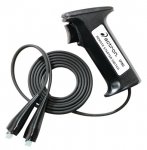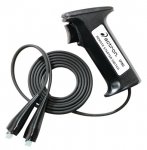I was able to go through most of the ignition system tests earlier today with the help of my dad. I followed the order laid out in my service manual.
Switch Box Stop Circuit Test
Manual says touch black/yellow switchbox wire to ground while cranking. Should see 200-360V DVA.
- Cold cranking = 211V
- Warm cranking = Did not attempt
Stator Output Test
Touching red lead to blue stator wire and black lead to ground checks the low speed while cranking. Touching the red lead to the red stator wire and the black lead to ground checks the high speed. Low speed should be 200V DVA minimum. High speed should be 20V DVA minimum.
- Cold cranking low speed = 250V
- Warm cranking low speed = Did not attempt
- Cold cranking high speed = 26V
- Warm cranking high speed = Did not attempt
Stator Resistance Test
Low speed is checked by placing one meter lead to the blue stator wire and the other lead to the red stator wire. Polarity does not matter. Low speed resistance should be 3600-4200 ohms. High speed should be 90-140 ohms.
- Cold cranking low speed = 4000 ohms
- Warm cranking low speed = 4200 ohms
- Cold cranking high speed = 116 ohms
- Warm cranking high speed = 112 ohms
Switch Box Bias Test
Connect the red lead to ground and the black lead to the white/black switch box terminal wire while cranking. Want to see 10-20V. Manual says less than 2V means a bad switchbox.
- Cold cranking = 1.4V
- Warm cranking = Did not attempt
Trigger Resistance Test
Disconnect all 4 trigger wires from the switchbox. Test the resistance between each of the 3 trigger sending wires and the trigger ground wire (black/white). Resistance should be 1100-1400 ohms for all three.
- Cold cranking = 1330, 1300, & 1300 ohms
- Warm cranking = Did not attempt
Stator Output Voltage Test (While Running)
Manual states to test the low and high speed voltage outputs while running between 1000-4000 rpms for ignition systems with erratic malfunctions. To test the low speed, probe the red lead to the blue stator wire and the black lead to ground while engine is running. Should see 200-330V DVA. For high speed, probe the red stator wire with the red lead and the black lead goes to ground. Should see 130-300V DVA.
- Cold cranking low speed = 240V
- Warm cranking low speed = 238V
- Cold cranking high speed = 106V
- Warm cranking high speed = Must have forgot to check
Stator Charging Wires Test
Tested the stator charging wires (both yellow) by connecting each to each lead of the multimeter. Manual says it should show 0.6-1.1 ohms. If it shows more replace stator. If it shows less I assume it also means replace stator. My meter?s smallest resistance setting is 200ohms so I?m not sure my results are accurate for the resistance test.
- Cold results = 0.3-0.4 ohms
- Warm results = 0.3-0.4 ohms
I also tested the AC voltage output of each lead with the motor running at around 2k rpms. My meter was set to 200V AC and I connected the red lead to the yellow wire and black to ground checking both stator wires.
- Results = No real reading on either yellow wire. Maybe saw 0.1 or so volts but nothing significant























